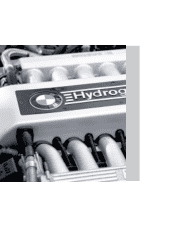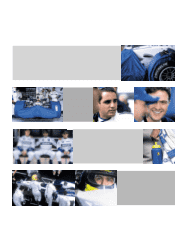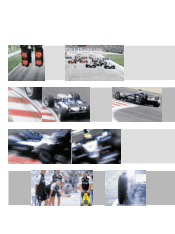BMW 2001 Annual Report Download - page 168
Download and view the complete annual report
Please find page 168 of the 2001 BMW annual report below. You can navigate through the pages in the report by either clicking on the pages listed below, or by using the keyword search tool below to find specific information within the annual report.
44
Preparation: The BMW WilliamsF1 Team is travelling the
world with 31 tonnes of cargo. Six tonnes thereof is for
BMW engines alone. At least 10 engines, spare parts
and tools for the three-litre 10-cylinder. The racing team
packs its bags 17 times a year, and the test team is out
on the road even more often. When the entire Formula 1
family travels to overseas destinations, 8 cargo Jum-
bos take off into the air, three of which carry the equip-
ment for digital television broadcasts. But even so, each
team struggles for every gram, taking along only what is
really essential.
Training: Each Grand Prix weekend starts with setting up the car. On tracks
such as Barcelona or Silverstone the team has lots of testing experience and
can use a wide range of data. So the basic set-up is already in place, with the
main focus on wind and weather conditions. Tracks such as Indianapolis or the
Hockenheim Ring require particularly good streamlining with their very long
straights and winding bends. To be really fast on the straights, the driver would
naturally prefer absolutely flat rear spoilers the less air resistance, the more
dynamically the BMW V10 can develop its power. But to be fast in winding
bends like in the Hockenheim Motodrom, the car needs substantial down-
forces even at relatively low speeds. The crucial point is to find the ideal com-
promise.
Qualifying: Hundredths of a second, sometimes even thousandths decide your position on the starting grid.
Everybody feels the tension when approaching the qualifying session on Saturday at 1.00 p.m. Is the set-up
ideal, do we have the right tyres? The BMW WilliamsF1 team even has its own professional weather fore-
caster. Tactics and timing are the key to success, and it is equally important to keep a close eye on the com-
petition. Who is going out when and on what tyres? What are his lap times? Where does the track appear
to be slippery? For example due to dirtying of the surface caused by a preceding race, or after a shower. Ralf
Schumacher and Juan Pablo Montoya are surprisingly relaxed, making jokes with wife or girlfriend, chatting
with the mechanics. 1.30 p.m. As long as the weather holds out, things will now become serious for the top
teams. At most, you will have four tries, the track becoming faster every minute, meaning that the surface
offers better grip. In many cases the driver who has the last word will end up No. 1. But there is always the
big risk of running into dense traffic in the last few minutes of qualifying.
Racing: 60 seconds to the warm-up lap. The
external starter has brought the
BMW V
10
to life. Following this lap, the 24 cars return
to their positions and the five red lights at the
start come on. The engines are revving to
their maximum limit. Once the last light goes
out, the on-board electronic control systems
will control rear-wheel spin. Like missiles, the
cars set out on their 300-km trial. Is our strat-
egy right? Are we really quick at the pits? Will
the car and engine last? Its a long, long way.
























